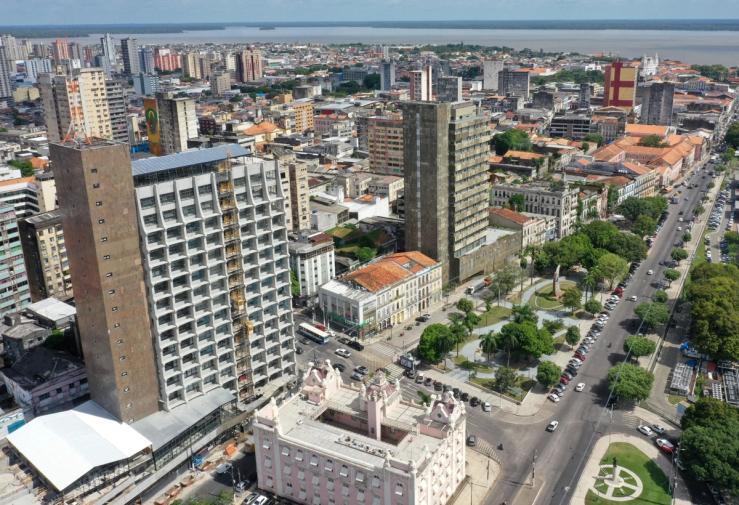The View From Davi and Barnabé
In the COP30 construction zone in Belém, a large fragment of native forest remains intact. One steps into it almost by accident. Under its dense canopy, just a few metres from cranes and rising concrete, the air cools, the light softens, and the noise recedes. The contrast is immediate.
With three months to go, in boardrooms and cabinet meetings across the world, dissent is growing around the idea of hosting the 30th UN Climate Change Conference in Belém. Rather than engaging with the COP30 agenda, focused on concrete climate action, we keep hearing: “How reasonable is it to organize a COP in the Amazon?”
When Brazil’s President Luiz Inácio Lula da Silva selected Belém to host COP30 two years ago, it was a bold and controversial choice. A port city of 1.3 million people, Belém is the capital of Pará, a state twice the size of France. And it embodies the region in ways that challenge global assumptions: The Amazon is one of the richest and most important forest ecosystems on Earth, and at the same time one of Brazil’s poorest and most structurally marginalized regions — an export hub in which less than 20% of residents have access to adequate sanitation. Though located in the world’s largest rainforest, Belém has lost nearly 20% of its tree cover in the last four decades. Illegal deforestation and informal urban growth exist hand in hand with rich cultural tradition, youth-led activism, and innovative governance models. The city is nationally recognized as a gastronomic hub, and is a central urban base for Indigenous and traditional peoples’ movements. Center and periphery, ecological and extractive, prosperous and precarious: these contradictions are Belém’s essence today.
By bringing COP30 to the Amazon, the Brazilian presidency is holding a mirror to the climate crisis, reflecting a dilemma that at least four billion people are confronted with: how to reconcile the urgent need for development with the long-term resilience needed to survive climate change. Far from a logistical miscalculation, Belém focuses global climate attention on the real, complex, and contested spaces that will determine the success of the transition, where investment in energy, transport, water, and housing must be re-thought to cut emissions, withstand shocks, and safeguard ecosystems, even as local people struggle to meet immediate needs.
On the ground in Belém, the picture is more nuanced than headlines suggest. Nearly $1 billion has already been invested in the city’s infrastructure, so while prices are still high, measures ranging from rental market incentives to alternative accommodation reflect a series of pragmatic measures.
And indeed, the Brazilian COP presidency has designed an action agenda that reflects this vision — of mobilization within a country’s means — and seems to address gaps left by recent hosts. New governance structures such as thematic envoys, a CEO-led executive team, and a Sustainable Business COP to aggregate the private sector’s participation, for example, aim to close the gap between past promises and delivery. The COP Presidency has widened the scope of this agenda to include health, jobs, and culture, reflecting the fact that climate resilience is a part of everyday life, and has also created mechanisms to amplify excluded voices, including Indigenous peoples as well as local communities, states, and youth.
After four years of isolation from global environmental affairs under former President Jair Bolsonaro, Brazil’s return to climate discussions, anchored in the Amazon, aims to reclaim its leadership and credibility within the international community. Brazil has the rare ability to speak credibly to both Global South and Global North. That duality gives Brazil — a large, biodiverse, unequal democracy navigating geopolitical and domestic instability while pursuing an activist vision — an opening to shift the narrative. Not to technical targets, but to concrete changes in how places, especially the poorest and most vulnerable, can ensure the health, security, and livelihoods of people amidst growing shocks.
In this light, Belém is not a backdrop but an integral part of the approach. So the question is not just whether it is reasonable to hold COP30 in Belém. The question is whether we will engage with a vision that may unsettle us, and face what that mirror reflects. Otherwise, we may still be unready or perhaps unwilling to confront the complete reality of the climate and nature crisis.
Room for Disagreement
The COP30 duality lies also at the heart of Brazil’s politics. The country seeks to project credibility abroad while not being fully consistent at home. Lula has made significant commitments to reducing deforestation and protecting Indigenous rights. In practice, however, the right-leaning Congress has recently passed legislation weakening environmental licensing, paving the way for increased deforestation. Domestic pressure to explore oil in the Amazon remains strong, including from Pará’s governor, Helder Barbalho, who is seen as a viable candidate to join Lula’s presidential ticket if the incumbent runs for reelection in 2026.
Davi Neustein is a sustainability consultant working on projects related to COP30 in collaboration with a range of non-governmental, philanthropic, and private sector organizations.
Barnabé Colin advises companies, governments and financial institutions on the interface between nature, policy, and sustainable finance at Systemiq.

